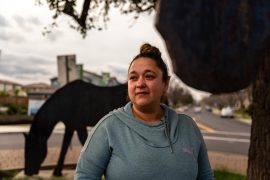1.65M Worldwide Now Receiving Antiretrovirals; More Children, Pregnant Women Need Drug Access, WHO Says
The number of people in sub-Saharan Africa with access to antiretroviral drugs has increased tenfold in three years, and 1.65 million people in low- and middle-income countries were receiving the drugs by the end of June, according to World Health Organization data released on Wednesday at the XVI International AIDS Conference in Toronto, London's Guardian reports (Boseley, Guardian, 8/17). Overall, 24% of the people in urgent need of HIV/AIDS treatment worldwide have access to the drugs, according to WHO (Fox, Reuters UK, 8/16). "The combined efforts of donors, affected nations, U.N. agencies and public health authorities are providing substantial, ongoing increases in access to lifesaving HIV treatment," Kevin De Cock, head of WHO's HIV/AIDS Department, said, adding, "While the 76% still untreated represents a predominantly empty glass, trends in scale-up nonetheless have been encouraging in the areas with the most people with HIV" (Duff-Brown, AP/Yahoo! News, 8/16). De Cock said although the treatment target of WHO's 3 by 5 Initiative -- which aimed to provide treatment for three million HIV-positive people in developing countries with antiretrovirals by the end of 2005 -- was not achieved, the initiative "helped change the landscape for HIV/AIDS treatment internationally forever" (Guardian, 8/17). De Cock declined to give an estimate of when the 3 by 5 goal would be met. He said that the first one million people in need of treatment are the easiest to reach because drug distribution programs typically begin in urban areas but that delivering drugs in rural areas is a "more difficult task and may take longer" (Altman, New York Times, 8/17). Jim Kim -- former director of WHO's HIV/AIDS Department and a professor of medicine at Harvard University -- on Wednesday said that he expects the 3 by 5 treatment target will be met by the end of 2007. He added that treatment efforts have increased in recent months, fueling hopes that the target will be reached by next year (Smith, Boston Globe, 8/17). According to De Cock, providing increased access to treatment also requires trained health workers, which many developing countries lack (New York Times, 8/17). De Cock also said another challenge would be to ensure sufficient funding to provide long-term treatment to the increasing number of people receiving antiretrovirals (Branswell, CP/CBC News, 8/16).
Children, Women
According to the WHO data, men and women are receiving antiretrovirals at equal rates (Guardian, 8/17). However, not enough children have access to the drugs, WHO says. About 800,000 of the 2.3 million HIV-positive children worldwide need access to antiretrovirals, De Cock said, adding that of the 800,000, only 60,000 to 100,000 are receiving them. Further, although children make up 14% of deaths from AIDS-related illnesses, they account for just 6% of people with access to treatment. In addition, less than 10% of pregnant women in developing countries have access to the antiretrovirals that can prevent mother-to-child HIV transmission, De Cock said. Injection drug users also are being left behind, especially in eastern Europe and central Asia, where IDUs make up 70% of HIV-positive people but just one-quarter of people are on antiretrovirals, according to De Cock. "An urgent priority is improving access to antiretroviral therapy for children, especially in sub-Saharan Africa, and for inject[ion] drug users everywhere," he said (New York Times, 8/17). De Cock also said that there is not universal access to the lowest available prices for antiretrovirals, and he called for HIV testing to be broadened immediately (Guardian, 8/17).
Kaisernetwork.org is serving as the official webcaster of the conference. View the guide to coverage and all webcasts, interviews and a daily video round up of conference highlights at http://www.kaisernetwork.org/aids2006. A webcast of the session where De Cock discussed the WHO data is available online.






